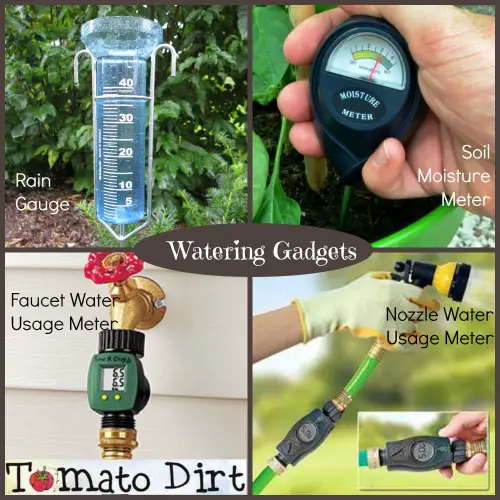FREE: 10 Must-Know Tomato Growing Tips Get The Guide
Read our affiliate disclosure here.
Watering Gadgets: Which Ones Do You Need for Growing Tomatoes?
Since 2010, Tomato Dirt has garnered 4.8+ million views, making it the web’s leading online source for growing tomatoes in the home garden. Award-winning writer and Tomato Dirt owner Kathy Widenhouse has helped thousands of home gardeners grow healthier tomatoes. Be one of them when you get Tomato Dirt’s Growing Guide here.
Updated 7.15.24
A gardening hose – you understand why you may need it.
But which other watering gadgets help you water wisely and grow healthy tomatoes?
Here's the dirt.
As you may know, tomato plants need 1-3 inches of water a week – on the low end of that scale during the cooler parts of the season and on the upper end of that range during hot spells and when the plants are putting out fruit.
How do you know if your tomato plants are getting enough water? We get that question a lot. Watering gadgets can help give you answers.
Watering Gadgets: Which Is Which?
Rain Gauge
A rain gauge is a device that collects and measures rainfall in a specific place. Gauges are available in a wide range of styles and prices, from high-tech automatic devices to very simple mounted versions.
Do you need one?
Your garden functions as a micro-climate. Rainfall patterns in your garden vary greatly with those reported through your local weather station. A cloudburst just down the road can miss dumping moisture on your thirsty plants. Your garden may get a nice shower while you are away and if you’re not around to see it or if you don’t track the amount, you may overwater your garden unnecessarily. While a rain gauge isn’t essential for good gardening, it is an extremely helpful gadget to have.
Special note: be sure to empty your rain gauge after each rainfall in order to get an accurate reading for the next time.
Soil Moisture Meter
Also called a soil moisture sensor, this tool measures water
content in the soil. Most versions for the home garden have a probe attached to
the meter box itself. You insert the probe into the soil, which senses and
reports the moisture volume in the soil in that specific area. You can track
different levels of soil moisture in different patches of your garden by taking
separate readings with the probe. This can show you if some parts of the garden
are receiving more water than others. You can use a soil moisture meter to help
you know if your tomato plants are getting too dry, but a more common use is to
track soil moisture to avoid overwatering. Meters report moisture levels in
different ways: some report the intensity on a scale of 1 to 10, for example,
while others report the data in percentages.
Be sure to clean the probe after each use according to manufacturer’s
instructions. A clean meter prevents corrosion and improves accuracy.
Do you need one?
The tomato jury is out on this one.
In the “against” column are those who argue that a moisture meter gives widely variable readings depending upon how deep into the soil you measure, where you measure, your soil compactness or looseness, the soil’s salt levels, the soil’s chemical or nutrient levels… even the state of meter batteries.
Those in the “for” column explain that less expensive versions are of course less accurate. Better technology means better reporting.
If you struggle to keep consistent watering – either too dry or too wet – then a soil moisture meter could be very helpful for you.
Water Usage Meter
These nifty watering gadgets allow you to track how much water you’re giving your plants through your watering system. Information from a water usage meter is particularly useful for tomato gardeners because the meter shows you how much water you are using either in a single watering or cumulatively.
A faucet meter attaches to your spigot on one end and the hose on the other. A nozzle meter attaches to the end of the hose and shows you how much water you are using as you spray your plants. You also can choose from a mechanical or a digital display. Be sure to choose the appropriate kind of meter for you.
Do you need one?
It’s easier to know if your tomato plants get enough water when you use a rain gauge and a water usage meter combined, because you’ll be able to track both concurrently. It’s in this way that a water usage meter is particularly useful.
Watering gadgets make gardening easier
Watering gadgets like a rain gauge, a soil moisture meter, and a water usage meter are not a “make or break” tool you need to grow tomatoes, but they sure are nice to have and they make gardening more convenient. And they are also nice gifts to give to the gardener in your life.
More Tips for Watering Tomatoes
Basics about watering tomato plants ...
Watering tomatoes when planting and just afterwards ...
How Often Do You Water Tomato Plants?
Watering tomatoes FAQs (Frequently Asked Questions) ...
Best techniques for watering tomato plants ...
Are you watering tomatoes enough?
Watering tomatoes in containers ...
How to choose a garden hose for watering tomatoes ...
Review: Self-Watering Tomato Planter ...
How to choose a garden hose ...
Get more helpful information on our Watering Tomatoes Pinterest board.
Return from Watering Gadgets to Tomato Dirt home
As an Amazon Associate and Rakuten Advertising affiliate I earn from qualifying purchases.
SHARE THIS PAGE:
FREE! 10 Must-Know Tomato Growing Tips: 20-page guide
Get yours here:





New! Comments
Have your say about what you just read! Leave a comment in the box below.